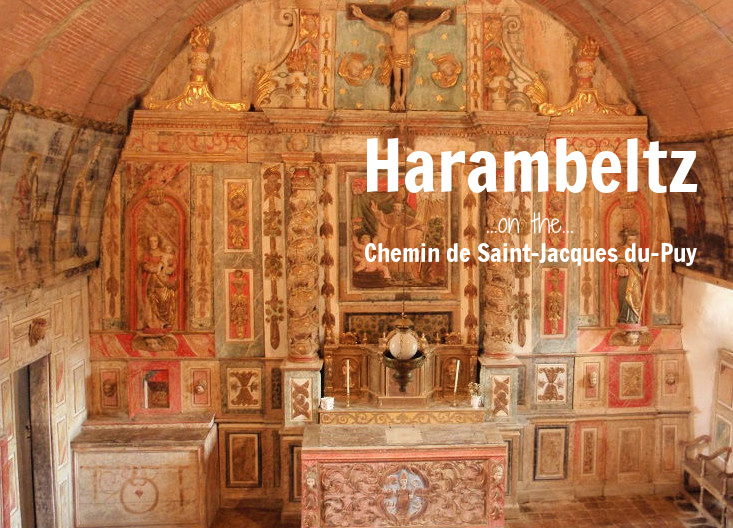
(Published October 2018, last updated April 2025)
On the 750-odd-kilometre walk along the Chemin de Saint-Jacques you’ll pass dozens, perhaps hundreds, of churches, chapels and cathedrals. But if you call in to only one on your way from Le Puy-en-Velay to Saint-Jean-Pied-de-Port, make it Chapelle Saint-Nicolas in Harambeltz.

Chapelle Saint-Nicolas
Most walkers pass through the tiny hamlet of Harambeltz with barely a sideways glance. If it’s approaching midday, you might consider taking advantage of the shade provided by the covered porch of the rustic church to rest your feet and enjoy a picnic lunch.
And yet, as I thought about how I would structure my suggested itinerary along this section of the GR 65, an overnight stop in Harambeltz was the first thing I locked in. Everything else was made to work around it.
Why is it so special?
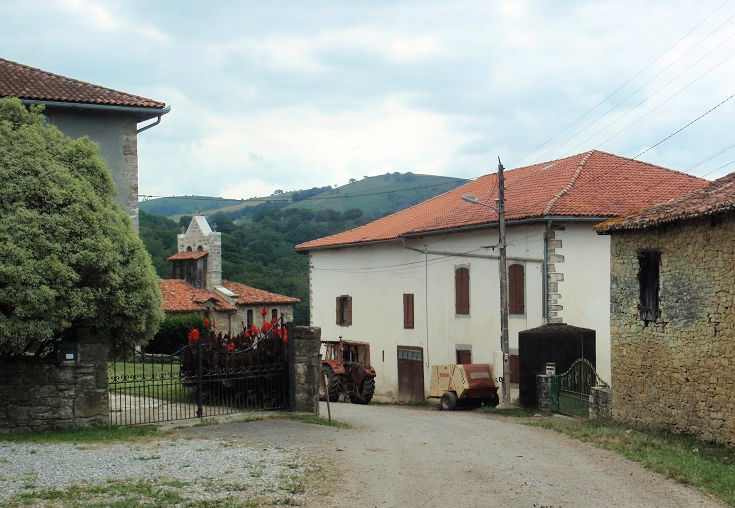
First impressions are likely to be of a small farming community, much like the 200 or so you have passed along the first 700 kilometres of the Chemin de Saint-Jacques. Just beyond the last house is a church—dedicated to Saint-Nicolas—and, let’s face it, you’ve passed a good many of those also!
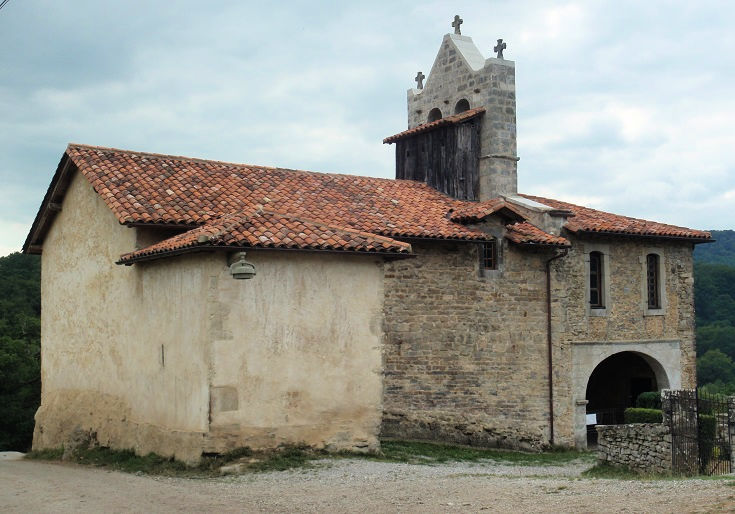
From the outside, the building is an odd mixture of stonework and patched stucco. Most of the current church dates from the twelfth and thirteenth centuries, although stones around the base of the building are thought to be much older—remnants of the original church built in the ninth or tenth century.
In the seventeenth century, the sacristy was added on the eastern wall, but 300 years later, the building was in much need of repair.
In 2001, the church was classified as an Historic Monument. Five years later, the local villagers formed an association—Les Amis d’Harambeltz—dedicated to preserving the building. Much-needed grants from local and regional governments added to funds provided by the villagers and, in June 2008, restoration work began.
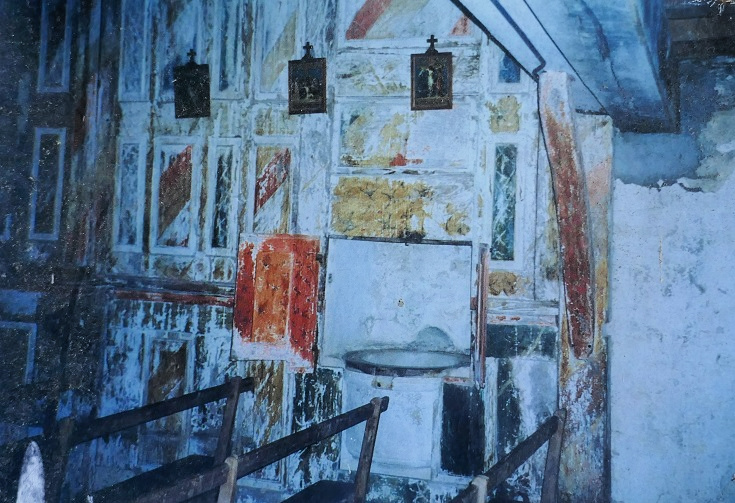
The interior of Chapelle Saint-Nicolas, prior to restoration work
By December 2010, the project was complete and the church was reopened to the public shortly afterwards.
At the entrance to the church, a few tables and chairs set out under a covered porch provide walkers with shelter from the heat or rain—an ideal spot to stop for lunch if you are not staying the night.
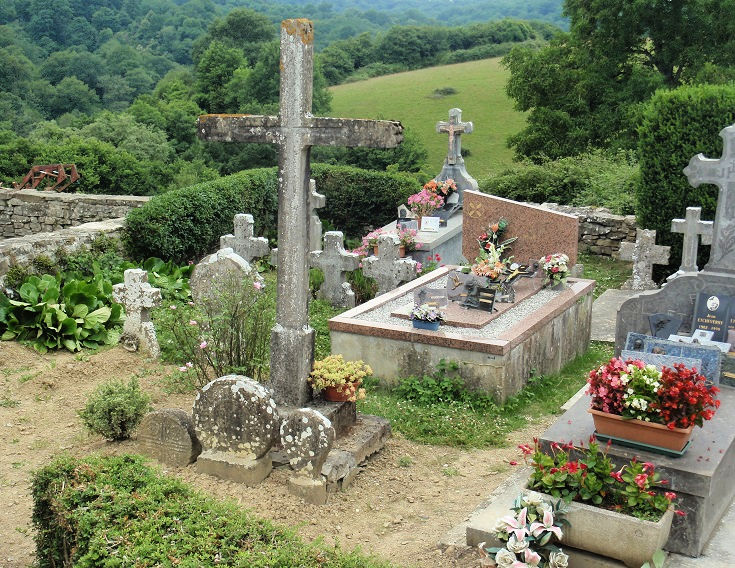
Pinned to the walls are several photos showing the history of the village, the progress of the restoration work and explanations of the tympanum and sculptures inside the chapel. The tableaus tell us there was once an infirmary attached to the church, probably as long ago as the eleventh century. (A painting of the church by Odilon Redon (1840—1916) which hangs in the Chicago Institute of Art shows the infirmary.)
Around this time (the eleventh century), farming communities played an important role in providing assistance and care to poor pilgrims. They formed into groups, known as Donats, and were subject to vows to the religious community of chastity, poverty and obedience to an elected Prior.
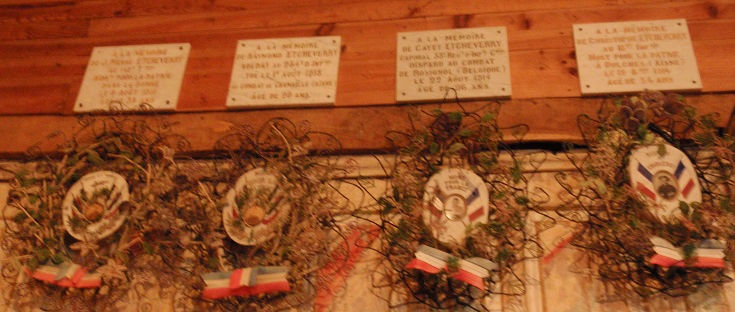
Harambeltz consists of only four farmhouses, yet the walls of the chapel pay tribute to four members of the Etcheverry family, lost during WWI
In 1784, Louis XVI relieved the Donats of their religious vows and a short time later, during the French Revolution in 1789, the church and infirmary were confiscated by the state and put up for sale. In 1795, the church and infirmary were bought by the owners of the four farmhouses (the Etcheverry, Etcheto, Salla and Borda families), and have been owned by their descendants since that day.

The beautifully restored interior of Chapelle Saint-Nicolas
Inside the church is a feast for the eyes. Faux marble walls are festooned with carvings, paintings and statues in shades of orange, apricot, blue and gold. It’s hard to know where to look first, so take your time and linger—soaking up the atmosphere and exploring all the details.
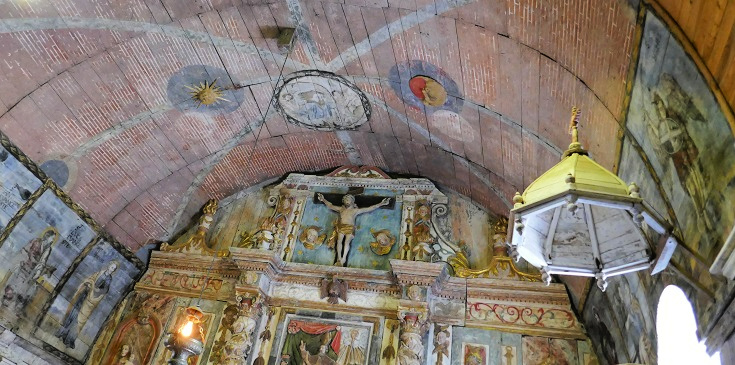
Detail in the ceiling of Chapelle Saint-Nicolas
I first visited Chapelle Saint-Nicolas in 2011, at the suggestion of Marie Josée, my host at Maison Ziberoa in Saint-Jean-Pied-de-Port. When we arrived, the church doors were open and we were welcomed inside by one of the villagers who offered a guided tour (unfortunately, my French was quite dismal at the time).
Since 2019, access to the interior of the church has been restricted, opening only for groups of ten or more visitors who have made prior arrangement. In July and August 2024, the church doors were reopened to visitors each Thursday between 2 pm and 6 pm. You’ll find any changes to these opening hours on the Friends of Harambeltz website. Entry is by donation and proceeds fund the continued maintenance of the church.
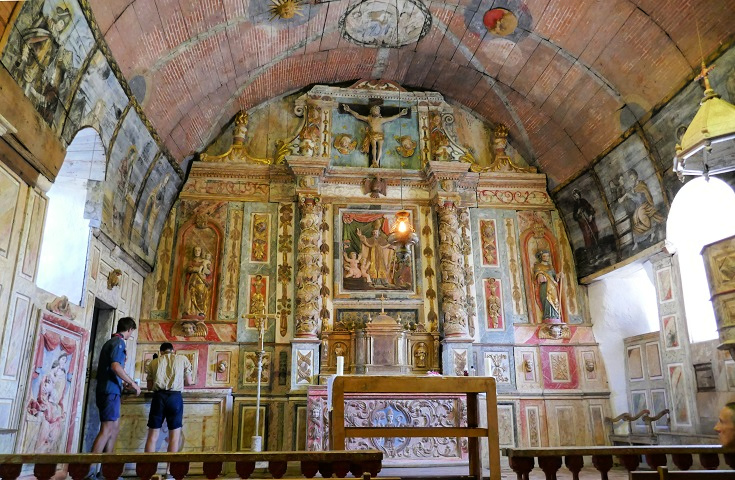
My visit inside Chapelle Saint-Nicolas in 2022 was made possible by a group of visiting Boy Scouts
If you are walking in a group of ten, I recommend that you contact the community via the website to arrange access to the church. If access is not possible, you’ll find a glimpse of the interior on the Etchetoa website.
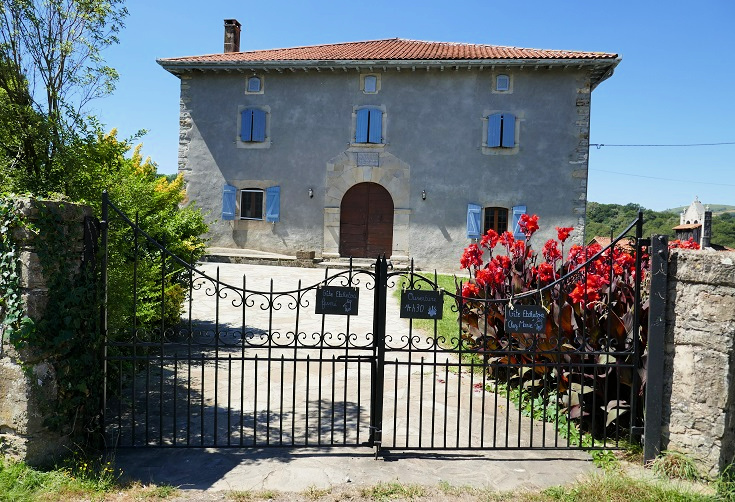
Gîte Etchetoa continues the tradition of providing pilgrims with warm hospitality and a delicious meal
In July 2022, I booked a room at Etchetoa, the only gîte in the village, aware that a visit inside the church was unlikely to eventuate. Late in the afternoon, a large group of Boy Scouts arrived and pitched their tents around the church grounds. You can imagine my delight when, later that evening, our host Marie announced that doors to the church were open and we were welcome to call in! I will keep my fingers crossed that such good luck awaits you also.
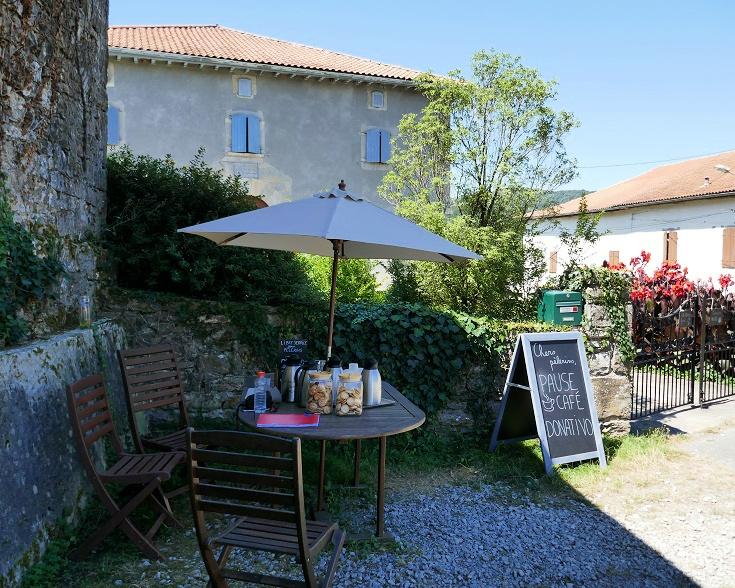
At the gate to Gîte Etchetoa, host Marie offers a selection of drinks and freshly made snacks, payment is by donation
Chapelle de Soyarza
If you arrive in Harambeltz via the variante that passes through Uhart-Mixe (as the majority of walkers do), you’ll miss another, less well-known gem along this section of the Chemin de Saint-Jacques. Instead of turning left towards Harambeltz when the variante reaches the GR 65, turn right and follow the GR 65 back towards Stèle de Gibraltar.
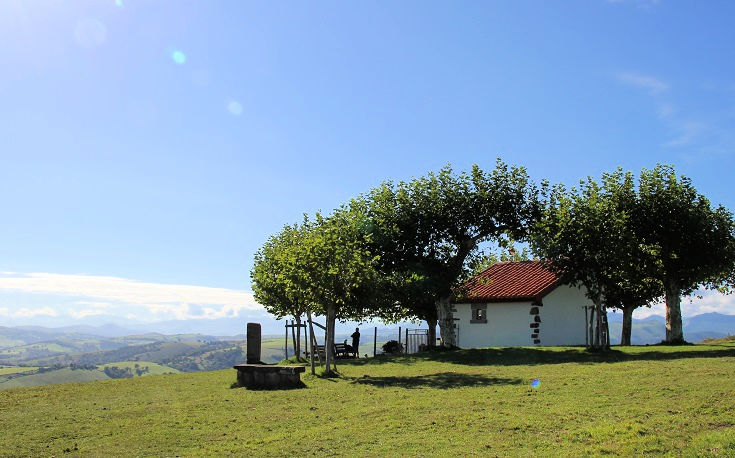
After fifteen minutes of gentle uphill walking, you’ll arrive at Chapelle de Soyarza. The chapel is small but the views are magnificent and well worth the extra time required to visit.
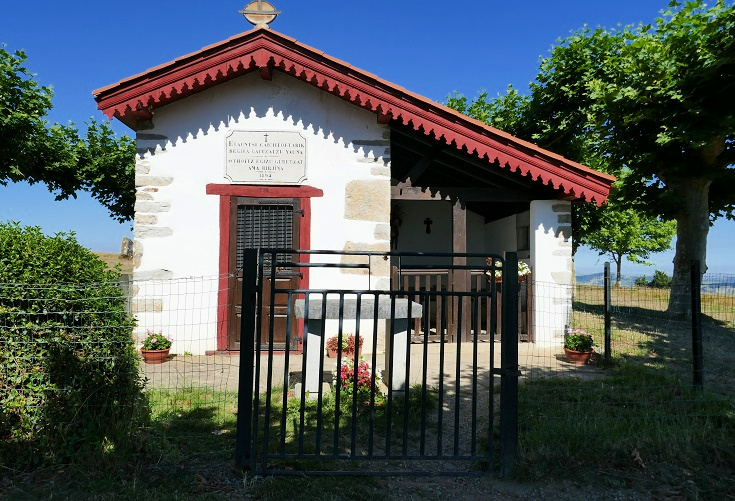
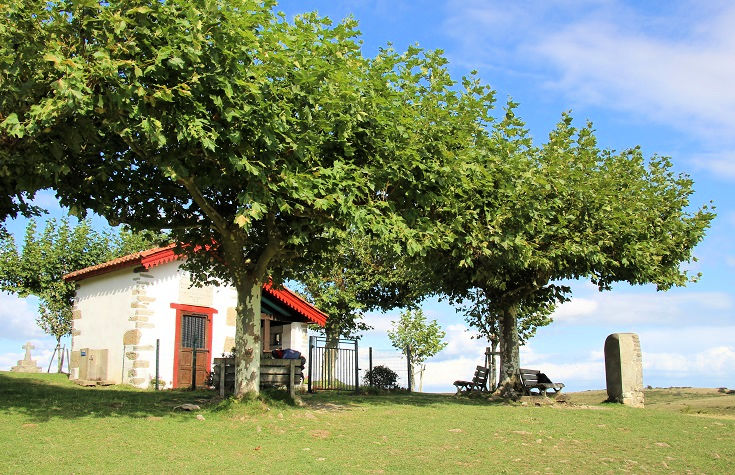
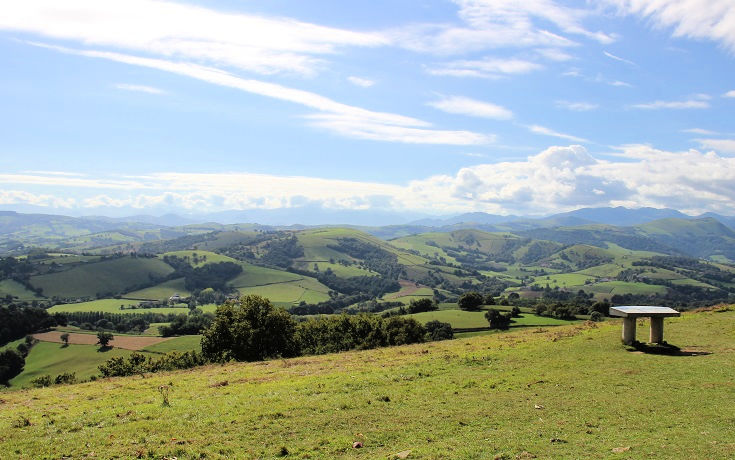
FAST FACTS
Which long-distance walk in France visits Harambeltz and the Chapelle de Soyarza?
Chemin de Saint-Jacques du-Puy (Stage 5: Eauze to Saint-Jean-Pied-de-Port)
Where is Harambeltz, France? Find it on Google maps
Harambeltz is located 714.6 kilometres (446.6 miles) along the traditional Chemin de Saint-Jacques path.
My preferred route follows the variante from Figeac through the Célé valley which increases the distance to 735.5 kilometres (459.7 miles)—a relaxed 41-day walk from the starting point of Le Puy-en-Velay and one day from the finishing point of Saint-Jean-Pied-de-Port. If you are pressed for time, the journey can be reduced to 33 days without sacrificing any of the highlights. Read more to learn all you need to know about both routes.
Click through to find my suggested itinerary for all five stages of the walk or click through onto each of the five stages to find faster itineraries.
If you prefer to set your own agenda, I share the steps I take to plan my itinerary on any long-distance walk (using the Chemin de Stevenson as a case study)
Transport options to and from Harambeltz
On weekdays, bus line 63 runs between Saint-Palais and Saint-Jean-Pied-de-Port, making stops at Uhart-Mixe, Ostabat-Asme (4 km/2.5 mi from Harambeltz), Larceveau, Mongelos, Lacarre and Saint-Jean-le-Vieux.
Accommodation in Harambeltz
The gîte in Harambeltz has been beautifully restored and reopened in April 2021 under the care of Marie, a former pilgrim and Camino walker. You’ll find all information, including tariffs, contact and booking details at:
Etchetoa (4 rooms, 15 people)
If Etchetoa is fully booked, I recommend walking a further 4 kilometres (2.5 miles) along the trail to the village of Ostabat-Asme where you’ll find accommodation at:
Gîtes
Gîte Izarrak (19 people)
Gîte Aire-Ona (4 rooms, 12 people)
Gîte Ospitalia (10 people)
Ferme Karricondoa (3 rooms, 8 people)
Maison Olli Pean (2 rooms, 4 people)
How to book accommodation in French
Where to eat in Harambeltz
In a shady corner in front of Gîte Etchetoa, Marie offers walkers a selection of hot and cold drinks and freshly baked treats. Payment is by donation.
Evening meals prepared using local produce are available for those staying in the gîte but guests are also welcome to prepare their own meals.
Practical tips for long-distance walking—preparation, packing and avoiding blisters
Purchase the Chemin de Saint-Jacques (PDF) guidebooks
Purchase five guidebooks covering Le Puy-en-Velay to Saint-Jean-Pied-de-Port
Look inside the CHEMIN DE SAINT-JACQUES DU-PUY (PDF) guidebooks
